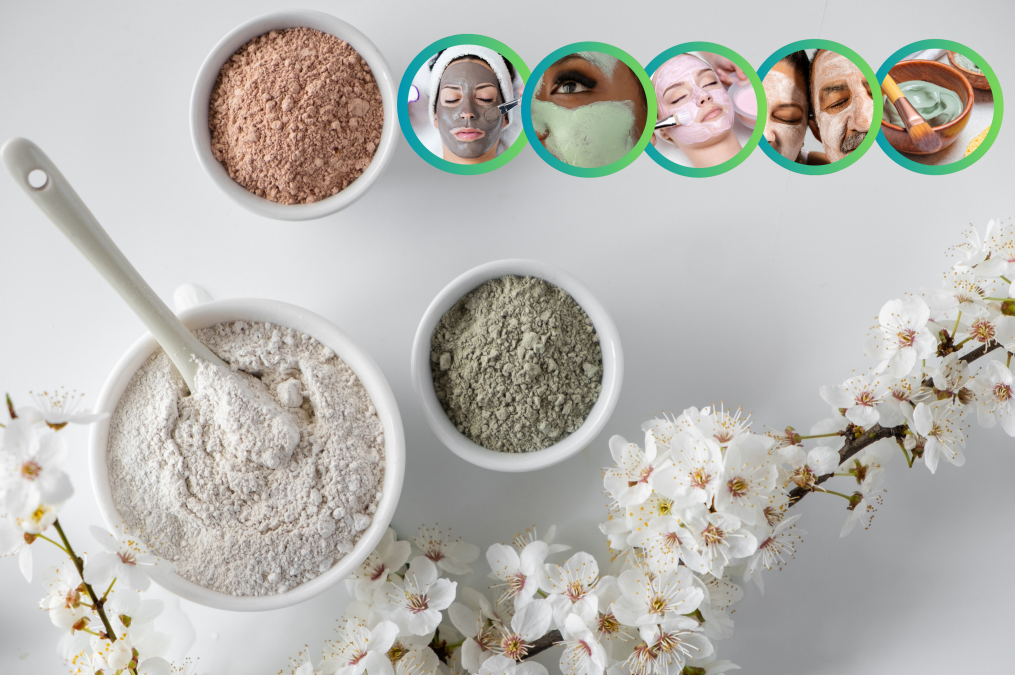
Using clay facial masks is convenient and cost-effective for individuals of all genders to indulge in self-care and revitalize their skin.
The tradition of applying clay for beauty dates back to ancient civilizations, including Ancient Egypt, Ancient Rome, and the Renaissance era. Throughout history, both men and women have utilized the healing properties of clay to attain a more radiant, smoother, and youthful appearance.
Clay face masks boast numerous benefits for the skin. Their natural ingredients aid in exfoliation, softening, extraction of impurities, minimizing pores, and reducing excess surface oil.
Tip: A handy tip for those dealing with active acne is to prepare a tiny amount of the clay mask and spot-apply it directly to the affected areas for targeted treatment.
Implementing an application technique that suits your skin type brings you closer to achieving a beautiful complexion.
Developing a personalized application method tailored to your skin’s needs brings you closer to achieving a radiant complexion.
Gather Clay Mask Ingredients and Equipment.
- Small non-metal bowl
- small non-metal spoon
- dry clay powder. Examples: Kaolin Clay, Bentonite Clay, Activated Charcoal, Sea Clay, etc.
- Water or Alcohol-free Hydroso.l Example: Chamomile, Witch Hazel, Rose water, Aloe Vera, etc.
- facial clay mask applicator brush
- natural cotton facecloth
- soft towel
Mixing The Clay Mask
Step 1: Measure approximately 1/2 to 1 tablespoon of clay into a dedicated clay face mask bowl or any small non-metallic bowl.
Step 2: Gradually incorporate 1/4 teaspoon of room temperature or warm water into the clay, stirring thoroughly with a non-metallic spoon. You can use an alcohol-free hydrosol like Chamomile, Which hazel, etc.
Step 3: Keep adding small increments of water while mixing until you achieve a creamy, mud-like consistency. Since different clays may require varying amounts of water, start with a small quantity and adjust as needed. Ensure thorough mixing until you achieve a smooth clay paste.
Step 1: Start with a freshly washed and dried face, ensuring it is free from makeup and moisturizers.
Step 2: Use a clay face mask applicator brush or a flat foundation brush to generously apply the mask to your face with your preferred technique. For optimal results, consider starting with a thin initial layer and then following up with a second, thicker layer, ensuring the mask reaches a thickness of approximately 1/8 inch.
Step 3: Leave the mask to dry for 5-10 minutes, though drying durations may differ based on the type of clay and your skin type. As the clay begins to dry, you may experience a sensation of pulling and tightening on your skin.
For oily skin or a deep, thorough cleanse, let the mask dry almost completely before removing it. So that you know, leaving the mask on longer has no added benefit and might lead to heightened tightness and redness. During drying, the clay extracts moisture from the skin’s surface.
For those with sensitive or dry skin or who want a gentler cleansing, allow the mask to dry only around the edges of the face and nose before removing it, which typically takes about 5 minutes.
How to Remove the Clay Mask:
Step 1: Gently Rinse and Pat. Dry: Using lukewarm water, gently rinse the clay mask from your face using circular motions with your fingertips. I like using warm water and my finger to remove the clay mass.
Tips: “To make removing the clay mask easier, consider moistening a facecloth with warm water and gently pressing it against your face before removing it. This technique can help rehydrate the mask and loosen its grip on your skin.”
Be sure to remove all traces of the mask, paying extra attention to areas where it may have adhered more firmly, such as around the nose and hairline.
Step 2: Once your face is entirely clean from the clay mask, pat it dry with a soft, clean cotton towel, avoiding any harsh rubbing that could irritate the skin.
Following the application of a clay mask, you may initially notice a sensation of tightness on your skin, possibly accompanied by a slight itchiness.
Clay promotes circulation, leading to temporary mild redness that may last about 30 minutes.
Step 3: To complete your Face care, Moisturize with your face cream or Facial serum oil. It’s imperative to complete this step for optimum results. Face cream or Facial serum oil
Step 4: Feel your revitalized skin’s smooth, soft embrace, inviting you to revel in its newfound freshness, radiance, and luxurious sensation!
Step 4: Conducting a skin patch test if you’re worried about skin sensitivity is advisable.
More On Clay Mask
Is cleaning my face (or shower) advisable before applying a facial clay mask?
The necessity of cleansing your face before applying a natural clay mask remains a topic of discussion, with conflicting information available online.
Based on many findings, many advocate removing surface dirt, oil, and makeup before applying the mask. This layer of grime may impede the clay’s active ingredients from effectively penetrating the pores and fulfilling their intended function.
Furthermore, applying a clay mask onto unclean skin may trap dirt, bacteria, and other impurities, potentially exacerbating pore congestion.
However, it’s important to note that this doesn’t involve a rigorous or exfoliating scrubbing process.
At Natralee Botany, we advocate using a gentle cleansing and exfoliating approach to facial cleaning that will not cause damage. The gentle facial cleanser removes excess dirt, oil, and traces of makeup.
Opting not to wash before applying a clay mask is a viewpoint held by some, particularly those concerned about potential drying effects, especially for individuals with dry or sensitive skin types.
The rationale behind this perspective is that washing can open pores, leading to more rapid absorption of anything applied thereafter. This may exacerbate irritation for those with sensitive skin. Similarly, moisturizing is often recommended immediately after washing to capitalize on this heightened absorption.
Our view at Natralee Botany is that the decision hinges on factors such as the type or purpose of the mask being used and individual skin type. For instance, if employing a deep cleansing mask for oily or combination skin, a preliminary wash with warm water can effectively open pores, priming the skin for a more thorough cleansing experience.
The same principle applies to deciding whether to shower before or after a clay mask treatment.
Pre-Shower Method: This approach is convenient when using deep cleansing masks for oily and combination skin types. The warm water and steam from the shower work together to open up your pores, enhancing the mask’s effectiveness.
Post-Shower Method: Applying the mask before a shower is preferable for individuals with drier skin. The warmth of the shower helps seal in moisture, preventing excessive drying of the skin.
I typically don’t wash my face before applying a clay mask. Since I don’t use makeup or heavy creams, my face is mainly exposed to dirt and pollutants. With my dry, mature skin, washing before the mask application tends to leave my skin feeling excessively dry afterward. Instead, I apply the clay mask, rinse it off, and then follow up with a moisturizer.
There is no perfect answer to whether one should wash one’s face before applying a clay mask.
However, if your skin feels oily, significantly dirty, or heavily coated with makeup, you might opt for a quick wash before applying the clay mask.
How often can I use a Clay Mask?
There isn’t a one-size-fits-all answer; as with any skincare regimen, observing how your skin responds to the treatment is crucial.
Due to their potent absorption properties, using a clay mask 1-2 times weekly is typically advisable. However, it’s important to note that more isn’t necessarily better.
Your skin type is the primary consideration in determining how often you should apply a clay mask, but it’s also essential to factor in the specific type of mask used on your face.
While your skin type primarily determines how often you should use a clay mask, it’s also essential to consider the type of mask you use. External factors such as weather and seasonal changes can also impact your skin’s needs.
Skin types generally fall into four categories: oily or acne-prone, normal, combination, dry, or mature.
Oily or acne-prone skin tends to be more resilient and may benefit from a more potent clay mask and a more frequent masking routine. However, it’s essential to start slowly and gradually increase usage. Beginning with 2 to 3 times per week may be suitable, but avoid using masks too frequently initially; instead, ease into it to allow your skin to adjust. Try our facial mask, Oily & Blemish Prone SkinActivated Charcoal & Kaolin.
Dry, sensitive, mature skin can be tricky to pinpoint, as it’s not a common skin type encountered regularly.
You can start by incorporating a gentle clay mask containing kaolin or rose clay into your routine once a week. Try our our facial Camu Camu & Rose Hibiscus
If you’d like, please increase the frequency to 2 or 3 times weekly. However, transitioning to masks with more potent drawing properties may increase sensitivity, so it’s best to proceed cautiously and adjust slowly.
Normal skin can be elusive, as it’s not a commonly encountered type. Start by incorporating a gentle mask, such as those with kaolin clay, into your routine once a week. If desired, gradually increase usage to 2 or 3 times per week. When trying different masks, be mindful that those with more potent drawing properties may increase irritation, so proceed cautiously and adjust slowly. Try our facial clay mask Normal to Oily Skin Organic Matcha Green Tea & Adzuki.
When is the Best Time to Apply a Clay Mask?
Applying a clay mask facial on a tranquil evening before bedtime provides a soothing way to unwind. Not only does it help eliminate impurities accumulated throughout the day, but it also allows your skin to rejuvenate overnight. Opting for an evening application is advantageous as any temporary redness caused by the mask can dissipate while you rest.
However, it isn’t advisable to immediately apply heavy makeup after a clay mask facial. If you do a morning mask session, give your skin an hour to rest before applying makeup.
Here’s a helpful tip: Please know how your skin reacts to the mask. Avoid trying a new face mask before heading out, as unexpected reactions can occur. Read our patch test article, and try our patch test if you are unsure.
